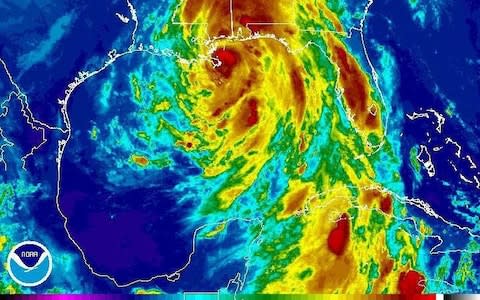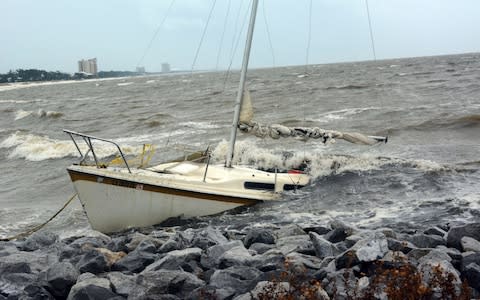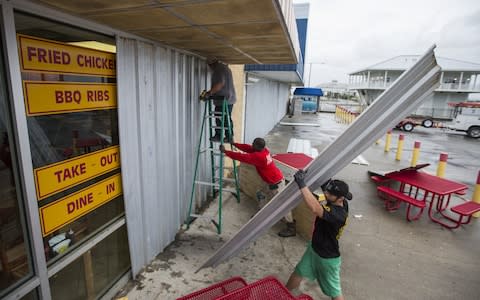Hurricane Nate crashes into Louisiana with winds of up to 85 miles per hour

Hurricane Nate slammed into the southeastern tip of the US state of Louisiana on Saturday and headed towards Mississippi after leaving dozens dead and causing widespread flooding in Central America.
Officials urged residents to evacuate some vulnerable areas before the storm made landfall on Saturday evening, and residents scrambled to make last-minute preparations ahead of the third hurricane to hit the southern US in less than two months.
But US President Donald Trump said federal officials were ready for the fast-moving storm, urging residents of the states of Louisiana, Mississippi, Alabama and Florida on Twitter to "listen to your local authorities & be safe!"
"The centre of Hurricane Nate is now making landfall at the mouth of the Mississippi River," the US National Hurricane Center (NHC) said at 7:00 pm Saturday (0000 GMT Sunday).
"On the forecast track, the centre of Nate will make a second landfall along the coast of Mississippi tonight. After landfall, the centre of Nate is expected to pass over portions of Mississippi, Alabama, and Tennessee late tonight through Sunday night," the NHC said.

If it moves as forecast, the worst of the storm will bypass New Orleans, which was ravaged by deadly Hurricane Katrina in 2005.
Heading north
The storm, a Category One hurricane on the five-level Saffir-Simpson scale, with winds swirling at up to 85 miles (140 kilometers) per hour, had slowed slightly from its earlier pace, heading north at about 20 miles per hour, the NHC said.
The forecast warned that "the combination of a dangerous storm surge and the tide will cause normally dry areas near the coast to be flooded by rising waters moving inland from the shoreline."
Alabama Governor Kay Ivey tweeted that she had asked Trump for a presidential declaration of emergency, "to ensure we have all possible resources in place to respond to Hurricane Nate."

Trump earlier issued an emergency declaration allowing federal aid to be sent to help mitigate the storm’s impact.
New Orleans issued a mandatory curfew for Saturday from 6:00 pm, and mandatory and voluntary evacuation orders were issued for certain low-lying areas.
Multiple shelters were opened for evacuees, and officials urged residents to finish preparations before evening, including stocking up on several days’ supply of food and water.
Stocking up on supplies
"I lived through Katrina and I know what that was like," said Jackie Daigre, 69, who was buying groceries at a busy Walmart store, where the shelves of bottled water were picked almost completely bare.
Officials said the recent hurricanes, devastating as they were, actually helped with preparations for Nate, since emergency supplies and assets deployed for the earlier storms were still in place. Still, the resources of the US Federal Emergency Management Agency (FEMA) have been stretched.
National Guardsmen were prepared to ride out the storm in the city’s huge Superdome arena, ready to respond once Nate passes over, the nola.com news website reported.

The city’s levee system has been considerably fortified since Katrina claimed some 1,800 lives in the region, but authorities warn that it has not completely eliminated flood risks.
Unlike Hurricane Harvey, which dumped record amounts of rain as it hovered over neighbouring Texas for a week, fast-moving Nate was expected to pass through quickly along a northerly path.
Still, Louisiana Governor John Bel Edwards warned that Nate could cause unexpected damage.
Power outages expected
"Anyone in low-lying areas... we are urging them to prepare now," he said.
In neighbouring Mississippi, lines formed at gas stations in areas along the potential path of the storm. Off the coast, some oil and gas rigs in the Gulf of Mexico have been evacuated.
With widespread electrical outages expected, New Orleans-area power provider Entergy prepositioned repair crews to go to work once the hurricane passed, and warned that outages could last up to a week.
The United States is recovering from two major hurricanes: Harvey, which tore through Texas and then Louisiana in August, and Irma, which slammed Florida in September.
Another powerful storm, Hurricane Maria, ripped through the Caribbean in late September, devastating several islands, including Dominica and Puerto Rico, a US territory.
Hurricane Maria pummels the Caribbean, in pictures
When Nate struck Central America on Thursday and Friday, at least 31 people were killed and others were still missing.
Intense rains forced thousands from their homes, uprooting trees, knocking out bridges and turning roads into rivers.
